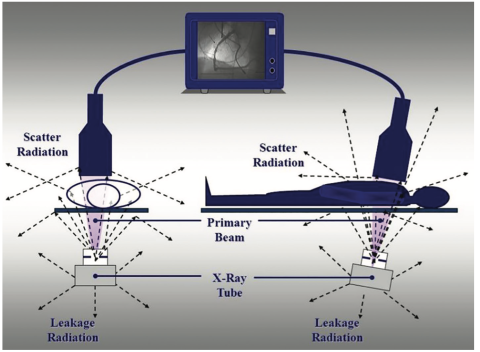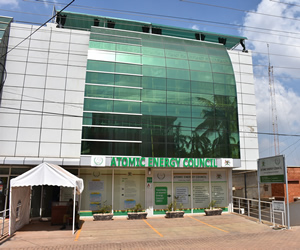In line with the Atomic Energy Regulations (AER), 2012, workers must not exceed the dose limit of 20 mSv/year averaged over 5 years and 50 mSv in a single year, while members of the public are not allowed to exceed a dose limit of 1 mSv/year under normal operating conditions.
Introduction
Radiotherapy is a cancer treatment technique that uses high doses of radiation to target and destroy cancer cells and tumors. Various practitioners work in radiotherapy, including Radiation technologists or radiographers, medical physicists, Radiation oncologists, Engineers, and Nurses. Because they work with high levels of radiation, these medical professionals can be exposed to radiation. If they are not properly protected, radiation exposure can lead to negative health effects. Think of radiation like the sun; too much sun can burn your skin or cause long-term damage, but with proper protection like sunscreen, you stay safe. In the same way, workers in cancer treatment centers need special safety measures to protect them from the invisible rays used to treat cancer.
Radiation exposure can have different effects depending on the amount and duration of exposure. If a person receives a large dose of radiation over a short period, they may experience immediate, short-term effects. Conversely, exposure to smaller doses over a long time might lead to long-term health risks. It’s therefore essential that radiation workers follow safety measures to minimize their risk.
Workers are at the forefront of life-saving cancer treatment efforts in radiotherapy, and their safety remains a top priority for the Atomic Energy Council (AEC). Through effective regulation, continuous education, and partnership with stakeholders, the AEC is steadfast in its mission to ensure that Uganda’s radiotherapy services are safe, secure, and of the highest quality. While radiotherapy benefits patients, workers are occupationally exposed to ionising radiation and must be protected
Current Status of Radiotherapy in Uganda
Uganda currently has one radiotherapy cancer treatment centre located in Mulago. The Atomic Energy Council, a government body overseeing the safe use of radiation, sets important guidelines for how radiation should be used in medical practices. As the government plans to establish more regional cancer centres to expand radiotherapy services nationwide, the need for effective radiation safety measures will become even more important to ensure that these new centres follow regulatory requirements to help protect both patients and healthcare workers.
Radiation Risks in Radiotherapy Practice
While radiotherapy is primarily intended as a treatment for cancer, it involves radiation exposure, which can have adverse effects. Radiation exposure can lead to both short-term and long-term effects, depending on the amount of radiation received. Short-term effects may occur with high doses received over a short period, while long-term effects can result from smaller doses accumulated over a longer period. Early side effects arise during or shortly after treatment and usually resolve within a few weeks. The most common early side effects include nausea, burns, skin reactions, fatigue, etc. Late side effects, such as cataracts and secondary cancers, as well as other complications affecting the lungs or heart, may develop over time.
In radiotherapy, workers may be exposed to external radiation from scatter radiation during normal operations and accidental situations, such as source misplacement, equipment malfunction, and inadequate shielding. The potential effects of radiation are classified into two categories: stochastic effects, which are probabilistic and do not have a dose threshold, and deterministic effects, which occur only after exposure exceeds a specific minimum threshold.
Radiation Safety Measures for occupationally exposed workers in Radiotherapy
In radiotherapy, ensuring the safety of workers from radiation is crucial. Here are some key safety measures that help protect them:
- Design of Treatment Facilities/Engineering controls: The rooms where the treatment machines are located (called bunkers) are specially built to reduce radiation leakage outside the containment. They use concrete to build walls and lead for the doors to keep radiation inside, which protects both workers and the members of the public. Other materials are also used to achieve the same shielding purposes.
- Inherent Safety Systems: The treatment machines have built-in safety features, for example, they won’t generate radiation if the door is open, and the collimator automatically shuts off to avoid unintended exposure. This helps prevent accidental exposure. There are also alarms that alert staff if radiation levels become too high, ensuring everyone stays safe.
- Adherence to Safety Principles: Workers are trained to follow important safety rules, such as working in shifts to reduce the radiation exposure per person, keeping a safe distance from treatment machines, and standing behind protective barriers. These practices help create a safer environment for everyone.
- Following Standard Operating Procedures: There are clear rules to reduce radiation exposure. For example, workers must wear their protective clothing before operating the machine and should never treat a patient if the treatment room door is open. Following these rules ensures safety for both workers and patients.
- Education and training of radiation workers: Workers are trained to follow important radiation safety principles. These principles help reduce their exposure to radiation, such as spending less time in areas where radiation is present, keeping a safe distance from the treatment machines, and always standing behind protective barriers or shields. Together, these measures create a safer environment for everyone involved.
- Adherence to Dose limits/Dosimetry monitoring: These are limits on radiation exposure that are established to ensure that radiation exposure to the workers does not exceed certain levels, preventing deterministic effects and reducing the probability of stochastic effects from occurring. The Atomic Energy Council sets the exposure levels, and investigations are conducted if a worker reaches these limits. In line with the Atomic Energy Regulations, 2012, workers must not exceed the dose limit of 20 mSv/year averaged over 5 years and 50 mSv in a single year, while members of the public are not allowed to exceed a dose limit of 1 mSv/year under normal operating conditions.Licenses are further required to set levels at which, if a worker reaches such doses, an investigation is conducted. These are called dose constraints and are established to ensure that workers don’t exceed dose limits.
- Dose Assessment of radiation exposure to the Occupationally Exposed workers: Although measures are taken to reduce radiation exposure to workers, some radiation exposure is unavoidable because these individuals work in radiation-prone zones. As such, measures are put in place to assess and quantify how much radiation is received by the workers to ensure that the radiation received does not exceed a specific level, “the Dose limit” established by the Atomic Energy Council. Special devices are used to assess the doses of workers. Figure 1 shows a thermoluminescent dosimeter (TLD) used to measure radiation received by workers, and Figure 2 demonstrates the wearing of the TLD. Workers wear special chips which are then read using specialised equipment. After reading, a dose amount is received to determine how much each chip captured, which in turn indicates how much the person wearing it accumulated. This helps determine the doses and assess how far workers are from reaching the established dose limits.





